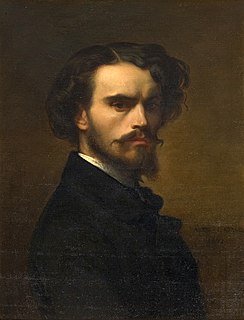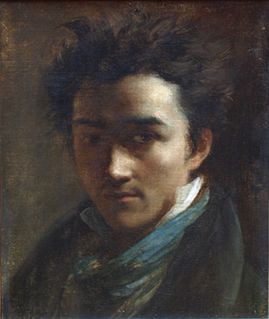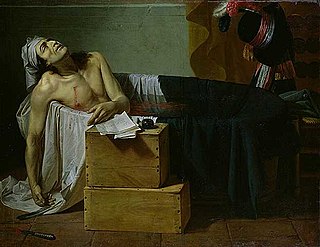 W
WLouis Boulanger was a French Romantic painter, lithographer and illustrator.
 W
WAlexandre Cabanel was a French painter. He painted historical, classical and religious subjects in the academic style. He was also well known as a portrait painter. According to Diccionario Enciclopedico Salvat, Cabanel is the best representative of the L'art pompier and Napoleon III's preferred painter.
 W
WMadame Cavé was a French painter and drawing professor. Born Marie-Élisabeth Blavot and also known as Marie Monchablon in her youth, she married the painter Clément Boulanger and then, after Boulanger's death, Edmond Cavé—whom she also outlived.
 W
WThéodore Chassériau was a Dominican-born French Romantic painter noted for his portraits, historical and religious paintings, allegorical murals, and Orientalist images inspired by his travels to Algeria. Early in his career he painted in a Neoclassical style close to that of his teacher Jean-Auguste-Dominique Ingres, but in his later works he was strongly influenced by the Romantic style of Eugène Delacroix. He was a prolific draftsman, and made a suite of prints to illustrate Shakespeare's Othello.
 W
WLéon Cogniet was a French history and portrait painter. He is probably best remembered as a teacher, with more than one hundred notable students.
 W
WAlexandre-Marie Colin (1798-1875) was a French painter of historical and genre subjects.
 W
WAlfred Dehodencq was a mid-19th-century French Orientalist painter born in Paris. He was known for his vivid oil paintings, especially of Andalusian and North African scenes.
 W
WFerdinand Victor Eugène Delacroix was a French Romantic artist regarded from the outset of his career as the leader of the French Romantic school.
 W
WPaul Delaroche was a French painter who achieved his greater successes painting historical scenes. He became famous in Europe for his melodramatic depictions that often portrayed subjects from English and French history. The emotions emphasised in Delaroche's paintings appeal to Romanticism while the detail of his work along with the deglorified portrayal of historic figures follow the trends of Academicism and Neoclassicism. Delaroche aimed to depict his subjects and history with pragmatic realism. He did not consider popular ideals and norms in his creations, but rather painted all his subjects in the same light whether they were historical figures, figures of Christianity, or real people of his time like Napoleon Bonaparte and Marie-Antoinette. Delaroche was a leading pupil of Antoine-Jean Gros and later mentored a number of notable artists such as Thomas Couture, Jean-Léon Gérôme, and Jean-François Millet.
 W
WEugène François Marie Joseph Devéria was a French Romantic history painter, portraitist and muralist.
 W
WAdèle Ferrand was a 19th-century French painter and draughtswoman on the island of La Réunion in the southwestern Indian Ocean.
 W
WJean-Louis André Théodore Géricault was an influential French painter and lithographer, whose best-known painting is The Raft of the Medusa. Although he died young, he was one of the pioneers of the Romantic movement.
 W
WAnne-Louis Girodet de Roussy-Trioson, also known as Anne-Louis Girodet-Trioson or simply Girodet(29 January 1767 – 9 December 1824), was a French painter and pupil of Jacques-Louis David, who participated in the early Romantic movement by including elements of eroticism in his paintings. Girodet is remembered for his precise and clear style and for his paintings of members of the Napoleonic family.
 W
WAuguste-Barthélemy Glaize (1807–1893) was a French Romantic painter of history paintings and genre paintings.
 W
WJoseph, Pierre, Tancrède Latour was a French Romantic Drawer and painter. His works are hosted by several museums in South of France.
 W
WCharles Joseph Auguste Migette was a French artist. A leader of the Metz School style of painting, he was a painter, stage designer, and art teacher.
 W
WVictor Nehlig was a French-American painter.
 W
WPierre-Paul Prud'hon was a French Romantic painter and draughtsman best known for his allegorical paintings and portraits such as Madame Georges Anthony and Her Two Sons (1796). Notably, he painted a portrait of each of Napoleon's two wives.
 W
WLouis Antoine Léon Riesener was a French Romantic painter.
 W
WGuillaume-Joseph Roques (1757–1847) was a French neoclassical and romantic painter.
 W
WJean Rouppert (1887–1979) was a French artist. He was a painter, a caricaturist and a sculptor.
 W
WAry Scheffer was a Dutch-French Romantic painter. He was known mostly for his works based on literature, with paintings based on the works of Dante, Goethe, and Lord Byron, as well as religious subjects. He was also a prolific painter of portraits of famous and influential people in his lifetime. Politically, Scheffer had strong ties to King Louis Philippe I, having been employed as a teacher of the latter's children, which allowed him to live a life of luxury for many years until the French Revolution of 1848.
 W
WXavier Sigalon was a French painter. He was one of the few leaders of the romantic movement who cared more for treatment of form than of colour.
 W
WJoseph-Noël Sylvestre (1847–1926) was a French artist, notable for his studies of classic scenes from antiquity. He was born in Béziers in South-West France on 24 June 1847, training as an artist first in Toulouse under Thomas Couture, then at the École des Beaux-Arts in Paris under Alexandre Cabanel. He was an exponent of the romantic Academic art style, also known as art pompier, examples of which are the Death of Seneca (1875), The Gaul Ducar decapitates the Roman general Flaminius at the Battle of Trasimene (1882), The Sack of Rome by the barbarians in 410 (1890) and François Rude working on the Arc de Triomphe (1893).